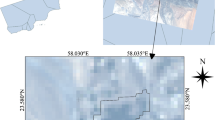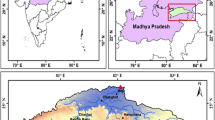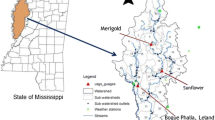Abstract
Understanding soil moisture at a small scale is beneficial for predicting productivity and management of both rained and irrigated agriculture in mostly smallholder communities. This study aims to accurately represent micro-watershed scale soil moisture using the optimization capability of SWAT (SUFI2) model and soil information derived from Sentinel 2 A level 1 C satellite images with OPtical TRApezoid Model (OPTRAM) and MNDWI. The study was carried in the 700 ha Awramba watershed in the Upper Blue Nile, Ethiopia. Calibration and validation of SWAT were performed using in-situ stream flow data to enable the accurate simulation of water balance components such as soil moisture. The spectral water index was evaluated using MNDWI from the green band (560 nm) and short wave infrared band (2190 nm). The Results were evaluated based on the runoff response n and soil moisture fit to measured values. The runoff fit against the measured data using Nash Sutcliffe Efficiency (NSE) and R2 criteria is 0.7 is and 0.75, respectively. The simulated daily soil moisture against the in-situ constant soil moisture provided NSE = 0.51, R2 = 0.77, RMSE = 0.19 and PBIAS = −0.242. The simulation results indicate that validation of SWAT, OPTRA M and MNDWI models with in situ soil moisture data leads to acceptable accuracy with 0.0027 cm3 cm−3, 0.0022 cm3 cm−3 and 0.034 cm3 cm−3 standard errors, respectively. Furthermore, Sentinel 2A imagery is found to have a higher potential to simulate soil moisture compared to TDR data. The overall study indicates satellite-based soil moisture provides an encouraging pathway to setting up soil moisture-based prediction for smallholder agriculture in Ethiopia.
Access this chapter
Tax calculation will be finalised at checkout
Purchases are for personal use only
Similar content being viewed by others
References
Falkenmark, M., Rockström, J.: The new blue and green water paradigm: breaking new ground for water resources planning and management. J. Water Resour. Plann. Manage. 132(3), 129–132 (2006)
Chen, H., Shao, M., Li, Y.: The characteristics of soil water cycle and water balance on steep grassland under natural and simulated rainfall conditions in the Loess Plateau of China. J. Hydrol. 360(1–4), 242–251 (2008)
Brocca, L., et al.: Soil moisture estimation through ASCAT and AMSR-E sensors: an intercomparison and validation study across Europe. Remote Sens. Environ. 115(12), 3390–3408 (2011)
Zhang, Q., Shi, Y., Zhu, R.: The study on landslide monitoring with TDR technology. Chin. J. Geol. Hazard Control 6(2), 67–69 (2001)
Narasimhan, B., Srinivasan, R.: Development and evaluation of soil moisture deficit index (SMDI) and evapotranspiration deficit index (ETDI) for agricultural drought monitoring. Agric. For. Meteorol. 133(1–4), 69–88 (2005)
Abate, M., et al.: Morphological changes of Gumara River channel over 50 years, upper Blue Nile basin, Ethiopia. J. Hydrol. 525, 152–164 (2015)
Koster, R.D., et al.: On the nature of soil moisture in land surface models. J. Clim. 22(16), 4322–4335 (2009)
Alexandridis, T.K., et al.: Spatial and temporal distribution of soil moisture at the catchment scale using remotely-sensed energy fluxes. Water 8(1), 32 (2016)
Baghdadi, N., et al.: Analysis of TerraSAR-X data and their sensitivity to soil surface parameters over bare agricultural fields. Remote Sens. Environ. 112(12), 4370–4379 (2008)
Entekhabi, D., et al.: The soil moisture active passive (SMAP) mission. Proc. IEEE 98(5), 704–716 (2010)
Arnold, J.G., et al.: Large area hydrologic modeling and assessment part I: model development 1. JAWRA J. Am. Water Resour. Assoc. 34(1), 73–89 (1998)
Yacoub, C., Foguet, A.P.: Slope effects on SWAT modeling in a mountainous basin. J. Hydrol. Eng. 18(12), 1663–1673 (2012)
Sadeghi, M., et al.: The optical trapezoid model: a novel approach to remote sensing of soil moisture applied to Sentinel-2 and Landsat-8 observations. Remote Sens. Environ. 198, 52–68 (2017)
Kubelka, P., Munk, F.: An article on optics of paint layers. Z. Tech. Phys. 12(593–601) (1931)
Korhonen, L., Packalen, P., Rautiainen, M.: Comparison of Sentinel-2 and Landsat 8 in the estimation of boreal forest canopy cover and leaf area index. Remote Sens. Environ. 195, 259–274 (2017)
Babiker, I.S., et al.: A GIS-based DRASTIC model for assessing aquifer vulnerability in Kakamigahara Heights, Gifu Prefecture, central Japan. Sci. Total Environ. 345(1–3), 127–140 (2005)
Kindie, A.T., Enku, T., Moges, M.A., Geremew, B.S., Atinkut, H.B.: Spatial analysis of groundwater potential using GIS based multi criteria decision analysis method in Lake Tana basin, Ethiopia. In: Zimale, F.A., Enku Nigussie, T., Fanta, S.W. (eds.) ICAST 2018. LNICST, vol. 274, pp. 439–456. Springer, Cham (2019). https://doi.org/10.1007/978-3-030-15357-1_37
Lodwick, W.A., Monson, W., Svoboda, L.: Attribute error and sensitivity analysis of map operations in geographical informations systems: suitability analysis. Int. J. Geogr. Inf. Syst. 4(4), 413–428 (1990)
McFeeters, S.K.: The use of the normalized difference water index (NDWI) in the delineation of open water features. Int. J. Remote Sens. 17(7), 1425–1432 (1996)
Setegn, S.G., Srinivasan, R., Dargahi, B.: Hydrological modelling in the Lake Tana Basin, Ethiopia using SWAT model. Open Hydrol. J. 2(1), 49–62 (2008)
Abbaspour, K.C., et al.: Modelling hydrology and water quality in the pre-alpine/alpine Thur watershed using SWAT. J. Hydrol. 333(2), 413–430 (2007)
Moges, M.A., et al.: Suitability of watershed models to predict distributed hydrologic response in the Awramba watershed in lake Tana basin. Land Degrad. Dev. 28(4), 1386–1397 (2017)
Asres, M.T., Awulachew, S.B.: SWAT based runoff and sediment yield modelling: a case study of the Gumera watershed in the Blue Nile basin. Ecohydrol. Hydrobiol. 10(2–4), 191–199 (2010)
Han, E., Merwade, V., Heathman, G.C.: Implementation of surface soil moisture data assimilation with watershed scale distributed hydrological model. J. Hydrol. 416, 98–117 (2012)
Babaeian, E., et al.: A novel optical model for remote sensing of near-surface soil moisture. In: AGU Fall Meeting Abstracts (2016)
Gitelson, A.A., et al.: Novel algorithms for remote estimation of vegetation fraction. Remote Sens. Environ. 80(1), 76–87 (2002)
Szabó, S., Gacsi, Z., Balázs, B.: Specific features of NDVI, NDWI and MNDWI as reflected in land cover categories. Acta Geogr. Debrecina Landsc. Environ. 10(3–4), 194–202 (2016)
Acknowledgements
The authors gratefully acknowledge Bahir Dar University and university of Connecticut for the research fund through its PIRE project. The authors also acknowledge European satellite agency (ESA) for enabling free sentinel images, National Meteorology Agency (NMA) of Ethiopia, and university of Gondar. The three anonymous reviewers and editors are gratefully acknowledged for their valuable comments on our manuscript.
Author information
Authors and Affiliations
Corresponding author
Editor information
Editors and Affiliations
Rights and permissions
Copyright information
© 2020 ICST Institute for Computer Sciences, Social Informatics and Telecommunications Engineering
About this paper
Cite this paper
Sinshaw, B.G. et al. (2020). Integration of SWAT and Remote Sensing Techniques to Simulate Soil Moisture in Data Scarce Micro-watersheds: A Case of Awramba Micro-watershed in the Upper Blue Nile Basin, Ethiopia. In: Habtu, N., Ayele, D., Fanta, S., Admasu, B., Bitew, M. (eds) Advances of Science and Technology. ICAST 2019. Lecture Notes of the Institute for Computer Sciences, Social Informatics and Telecommunications Engineering, vol 308. Springer, Cham. https://doi.org/10.1007/978-3-030-43690-2_20
Download citation
DOI: https://doi.org/10.1007/978-3-030-43690-2_20
Published:
Publisher Name: Springer, Cham
Print ISBN: 978-3-030-43689-6
Online ISBN: 978-3-030-43690-2
eBook Packages: Computer ScienceComputer Science (R0)




